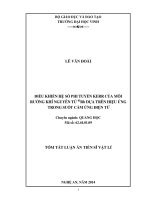Section 4 2 TRƯỜNG ĐIỆN TỪ
Bạn đang xem bản rút gọn của tài liệu. Xem và tải ngay bản đầy đủ của tài liệu tại đây (169.17 KB, 15 trang )
Slide Presentations for ECE 329,
Introduction to Electromagnetic Fields,
to supplement “Elements of Engineering
Electromagnetics, Sixth Edition”
by
Nannapaneni Narayana Rao
Edward C. Jordan Professor of Electrical and Computer Engineering
University of Illinois at Urbana-Champaign, Urbana, Illinois, USA
Distinguished Amrita Professor of Engineering
Amrita Vishwa Vidyapeetham, Coimbatore, Tamil Nadu, India
4.2
Dielectrics
4.2-3
Dielectrics
are based upon the property of polarization, which is the
phenomenon of the creation of electric dipoles within the
material.
Electronic polarization: (bound electrons are displaced to
form a dipole)
E
+
-
Q
+
d
-Q
-
Dipole moment
p = Qd
4.2-4
Orientational polarization: (Already existing dipoles are acted
upon by a torque)
QE
+
q
d
q
-
E
Torque QEd sin
Direction into the paper.
T Qd × E
p × E
- QE
Ionic polarization: (separation of positive and negative ions
in molecules)
4.2-5
The phenomenon of polarization results in a polarization
charge in the material which produces a secondary E.
- rS0
z=d
-
-
-
-
-
-
-
+
+
+
-
Ea
e e 0
z=0
+
+
+
+
rS0
z=d
z=0
+
-
+
-
+
+
-
+
+
+
-
+
pS pS 0
+
+
+
+
-
+
+
+
-
+
ES
-
pS pS 0
+
-
+
+
-
+
+
+
-
t
+
+
E+
+
+
4.2-6
Polarization Current
4.2-7
To take into account the effect of polarization, we define the
displacement flux density vector, D, as
D 0E P
= 0 E 0 e E
= 0 1 e E
= 0 r E
= E C m2
= permittivity, F m
r = relative permittivity
r and vary with the material, implicitly taking into account
the effect of polarization.
4.2-8
As an example, consider
S 0
-
-
-
-
-
-
-
z=d
z
+
+
+
+
S 0
+
Then, inside the material,
+
+
z=0
S 0
S 0
E
az
a z
2
2
S 0
az
D E S 0 a z
4.2-9
D4.3
1 C m2
-
-
-
-
-
-
-
z=d
z
4 0
+
+
+
+
+
+
1 C m2
For 0 < z < d,
6
(a) D S 0az 10 a z C m
2
+
z=0
4.2-10
D
1
6
(b) E
10
az
4 0
36
6
10
az
9
4 10
9000 az V m
(c) P D 0 E
= 10 6 az 0.25 10 6 az
0.75 10 6 az C m2
4.2-11
Isotropic Dielectrics:
D is parallel to E for all E.
y
Dx Ex
D
Dy Ey
Dz Ez
D E
E
x
Anisotropic Dielectrics:
D is not parallel to E in general. Only for certain directions
(or polarizations) of E is D parallel to E. These are known
as characteristic polarizations.
4.2-12
Dx xx Ex xy Ey xz Ez
Dy yx Ex yy Ey yz Ez
Dz zx Ex zy Ey zz Ez
y
E
D
x
Dx xx
D
y yx
Dz zx
xy xz Ex
yy yz Ey
zy zz Ez
4.2-13
D4.4
8 2 0
2 5 0
0 0 9
(a) E E0 az
Dx
8 2 0 0
0
D 2 5 0 0 0
0
0
y
Dz
0 0 9 E0
9 0
D 9 0 E0 az 9 0 E
eff 9 0 , reff 9
4.2-14
(b) E E0 a x 2a y
Dx
8 2 0 E0
4 E0
2 5 0 2 E 8E
D
0
0
0
0
y
Dz
0 0 9 0
0
D 4 0 E0 ax 2a y 4 0 E
eff 4 0 , reff 4
4.2-15
(c) E E0 2ax a y
Dx
8 2 0 2 E0
18 E0
D 2 5 0 E 9 E
0
0
y
0
0
Dz
0 0 4 0
0
D 9 0 E0 2ax a y 9 0 E
eff 9 0 , reff 9









